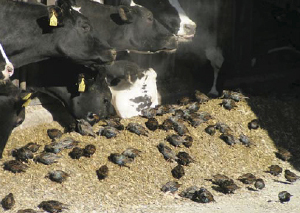- Return to Article Of The Month index
Bird Control to Minimize Feed Storage Losses
October, 2014
Courtney Davis - Extension Agent I, Dairy/Water Quality,
Okeechobee County Extension
 Birds can negatively affect the profitability on your farm. One concern is the potential of disease transmission. Since birds travel from farm to farm they can easily transmit diseases. They can carry Salmonella, although they are not considered great risk for carriers of Salmonella. And they also can carry Cryptococcosis. This is a fungal disease spread by pigeons and starlings to livestock that may result in chronic, usually fatal, meningitis.
Birds can negatively affect the profitability on your farm. One concern is the potential of disease transmission. Since birds travel from farm to farm they can easily transmit diseases. They can carry Salmonella, although they are not considered great risk for carriers of Salmonella. And they also can carry Cryptococcosis. This is a fungal disease spread by pigeons and starlings to livestock that may result in chronic, usually fatal, meningitis.
The greatest concern about birds on your farm should be the consumption of feed. Although one bird does not consume a lot of feed when you have a couple hundred eating your feed they can be extremely detrimental to your feed costs. It is estimated that in a week, 200 starlings can eat 175 pounds of grain and contaminate that much or more with droppings and throwing the feed out of the bunk. It is estimated that bird populations can cause an annual loss of $100 million to U.S. agriculture.
Laws and Regulations
Federal and state regulations protect most blackbirds and other migratory birds. A federal permit is required to take, posses or transport migratory birds for depredation(act of consuming agricultural resources) control purposes. No federal permit is required and control measures, including lethal methods, may be taken when these species are “found committing or about to commit depredation,” or when they “constitute a health hazard or other nuisance. Starlings, pigeons, and sparrows are not protected by federal or state laws.
Control Methods
The best way to control the birds is to stop them before they become a problem. Methods that have proved to be successful are starting early before the birds form a strong attraction to the site; be persistent until the problem is solved; and using a variety of techniques. Control techniques include trapping, bird-proofing, habitat modification, frightening, repellants, shooting and toxicants.
Live trapping – Use live birds as a decoy to catch 100 or more starlings a day, which then can be euthanized. Non-target species of birds should be freed.
Exclusion and bird-proofing – Cover all openings such as eves and ridges with bird-proof netting and/or plastic strips.
Cultural Methods/Habitat Modification- Limit access to water by making sure that water levels in waterers are low enough so birds cannot perch on the edge to drink.
Shooting – Can be very effective population control for smaller number of birds. Notify authorities and neighbors if necessary.
American Kestrels- These birds of prey eat rodents and small birds providing a natural biological control method.
Toxicants/Avicides: Avitrol, Starlicide Complete, and DRC-1139 are products that are currently approved for use in some states. A pre-bait process should be used for all avicides. This process simply makes an attractive bait available to birds for several days in order to establish a feeding pattern. The untreated pre-bait should be placed in a carefully selected place, safe from consumption of other animals. Select a site that is protected from the wind and that is in full sun to get the best results. After acceptance of the pre-bait is accepted and no non-target birds are present, the toxicant is added. Depending on the toxicant used, treated birds will die within 24-36 hours. Dead birds can be disposed of in the trash, manure pit, buried, or incinerated if it complies with local regulations. Make sure that neighbors and appropriate local authorities are notified because many of the birds will die off-site. Make sure to check with FDACS for regulatory information.

